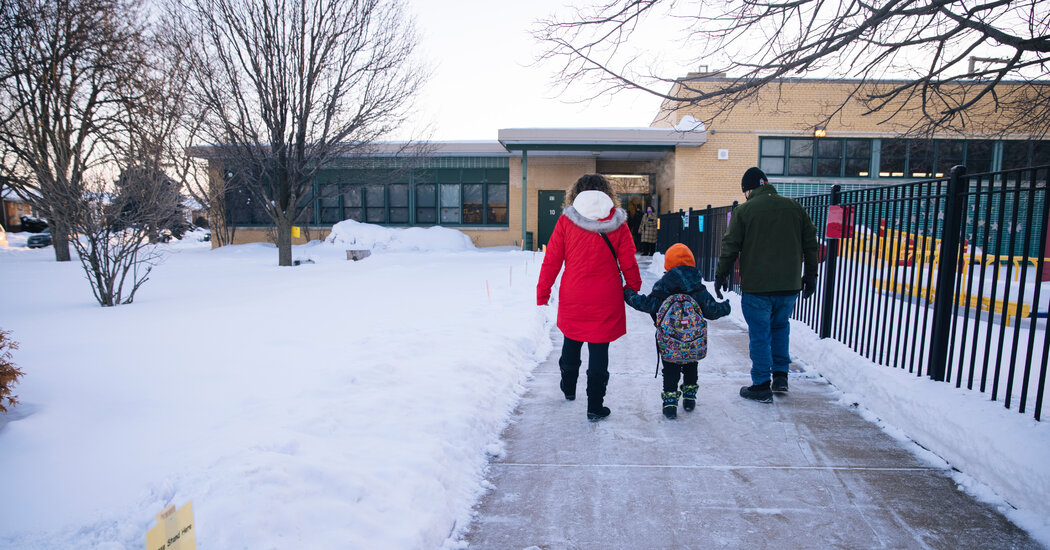What You Need to Know About the CDC's New School Guidelines

In a move long awaited by educators, the Centers for Disease Control and Prevention released new guidelines on Friday for how to operate schools safely during the pandemic.
The recommendations, more detailed than those released by the agency under the Trump administration, attempt to carve a middle path between people who want classrooms to reopen immediately and those teachers and parents who remain reluctant to return to in-person instruction before widespread vaccination.
What do the guidelines say about reopening classrooms?
With proper mitigation, such as masking, physical distancing and hygiene, elementary schools can operate in person at any level of community virus transmission, the guidelines state.
The document says that middle and high schools can safely operate in person at all but the highest level of transmission, which is defined in two ways: when 10 percent or more of the coronavirus tests in a community come back positive over a seven-day period; or when there are 100 or more virus cases per 100,000 people in the community over seven days.
Middle and high schools may open at any level of community spread if they conduct weekly coronavirus testing of students and staff members. The agency also recommended that at higher levels of community spread, all schools reduce attendance by having students come to class on different days or by having some groups of students learn virtually.
The guidelines say teacher vaccination, while important, should not be considered a prerequisite for reopening shuttered schools.
Will school districts be required to adopt them?
No, these are recommendations. A majority of the nation’s school districts are already operating at least partially in person, and the guidelines say that they may continue to do so, even when community transmission is high.
Is there a way to see if my school can safely open under the C.D.C. guidelines?
Sort of. You can look up your community’s test positivity rate and the number of new cases per 100,000 people in the last seven days (these numbers are often available on state or county websites, though you might need to do some math to get the rate per 100,000 people), then compare the agency’s policy recommendations for that level of transmission with what your school is doing. But the guidelines acknowledge that some schools have been safely open at higher levels of community transmission than the recommendations advise.
Will these guidelines encourage more districts to bring students back into classrooms?
It’s hard to say. In many districts that remain closed, labor issues are the major barrier to reopening. Some local teachers’ unions are demanding teacher vaccination, accommodations to allow teachers with vulnerable relatives to continue working from home, and more stringent safety measures in buildings. But the guidelines might help districts and unions reach consensus by pointing to established research on how to operate schools safely during the pandemic.
What do doctors and public health experts think of the guidelines?
They were greeted warmly by many coronavirus experts, who have long argued that schools should be the last places to close and the first to reopen amid the pandemic. Some were puzzled, however, by the lack of emphasis on air quality, and what they said was a misguided focus on cleaning surfaces, given that experts now believe that the virus is largely transmitted through the air.
Others said they thought the thresholds for opening middle and high schools were too restrictive, noting that some schools have operated safely through the pandemic at higher levels of community transmission.
Class Disrupted
Updated April 22, 2021
The latest on how the pandemic is reshaping education.
What do teachers’ unions think of them?
Both of the national unions said they were pleased to see the C.D.C. release clear, detailed guidelines based on science. But both had some concerns.
Randi Weingarten, president of the American Federation of Teachers, has more strongly emphasized the importance of in-school virus testing. And Becky Pringle, president of the National Education Association, echoed expert concerns about the guidelines’ lack of emphasis on air quality. She was also not happy about what she perceived as wiggle room in the language on physical distancing, which left the impression that six feet was ideal, but not strictly required.
How do these guidelines compare to those the C.D.C. issued during the Trump administration?
The new guidelines are significantly clearer; they could be read as being more strict, but they also discuss evidence that schools can open safely at any level of community transmission. The previous guidelines suggested that schools use similar indicators of community transmission to make decisions about whether to open, but provided limited guidance. Both the earlier recommendations and the new guidance allow schools flexibility to make decisions based on individual factors.
Do the guidelines say whether schools can ease up on precautions like mask wearing and distancing once teachers are vaccinated?
Only vaguely. The C.D.C. says that mitigation strategies will need to continue “until we better understand potential transmission among people who received a Covid-19 vaccine and there is more vaccination coverage in the community.” Many experts believe that some precautions, like masks, will be warranted until all students are vaccinated; there are currently no vaccines approved for children.
Whether schools will need to continue to enforce social distancing or keep students in small cohorts is less clear. A model that examines the effects of different mitigation strategies in schools predicts that vaccinating teachers will have a significant effect in reducing transmission, possibly making distancing and keeping students in cohorts less important.
Do the guidelines apply to private schools?
The document does not distinguish between public and private schools, and the recommendations could be adopted by any school. Private schools are more likely to be open currently than public schools, though they are also subject to state regulations about how to operate safely during the pandemic.
Published at Sat, 27 Mar 2021 14:17:09 +0000
Article source: https://www.nytimes.com/2021/02/12/us/cdc-school-guidelines-faq.html